 Tsitsit, fringes or tassels, on the corners of garments originates in the biblical commandment:
Tsitsit, fringes or tassels, on the corners of garments originates in the biblical commandment:
Contrary to some popular belief, apart from the Tallit and Fringes there is no particularly Jewish style of dress. The long black kaftan and broad-rimmed hats which some think of as the way Jews dress is worn only by a minority of extremely Orthodox, particularly by a sect known as Chasidim. To think of this as typically Jewish is roughly to think of the clothes of the Amish people as typically Christian dress. The style of the Chasidim was copied from that of gentile Polish nobility of the 17th century. Due to the conservative nature of Chasidism, this style has changed little since it was first adopted by the early followers of the sect.
Although styles of dress of Jews throughout the world varies greatly, there are still certain laws and customs that apply to both clothing and general appearance.
The custom of putting  Tsitsit, fringes or tassels, on the corners of garments originates in the biblical commandment:
Tsitsit, fringes or tassels, on the corners of garments originates in the biblical commandment:
Speak to the people of Israel, and bid them that they make them fringes in the borders of their garments throughout their generations, and that they put upon the fringe of the borders a thread of blue; And it shall be to you for a fringe, that you may look upon it, and remember all the commandments of the Lord, and do them.1.
(1.) Numbers 15, 38-9.
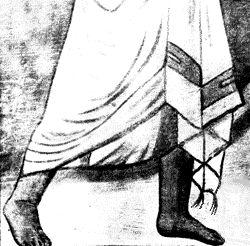 |
mural, Babylon/Syria 3rd Cent CE. |
The custom is clearly old and was probably a form of tribal identification, which separated the Israelites out from gentiles. This is shown by the fact that a Jew was not allowed to sell a garment with fringes to a non-Jew without removing the fringes first.2.
By the time of the Mishnah in the early 3rd Century fringes were accepted as a long-standing practice. However, the Rabbis were still arguing just how many blue and how many white threads were required.3. (see WHY A BLUE THREAD?) The blue  (T'chelet) was provided by the dye obtained by a sea snail called in Hebrew
(T'chelet) was provided by the dye obtained by a sea snail called in Hebrew  Chilazon. But these became scarce and the Mishnah permitted the use of tsitsit with all white threads.4. Eventually a severe snail shortage caused people to stop and then forget the dyeing process. Today it is the custom to have undyed fringes. Only a minority want to introduce the use of blue threads, in case it is the wrong dye or the wrong colour, and so invalidate the fringe. (But see also TYPES OF TSITSIT)
Chilazon. But these became scarce and the Mishnah permitted the use of tsitsit with all white threads.4. Eventually a severe snail shortage caused people to stop and then forget the dyeing process. Today it is the custom to have undyed fringes. Only a minority want to introduce the use of blue threads, in case it is the wrong dye or the wrong colour, and so invalidate the fringe. (But see also TYPES OF TSITSIT)
 | 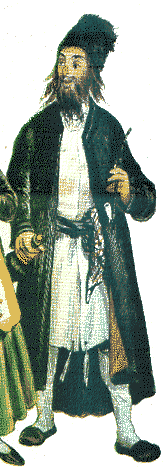 |
Germany, 15th Cent. | Poland, 18th Cent. |
A further development occurred when Jews who moved into Europe adopted modern dress. Unlike the rectangular sheet of Eastern garments, western clothes did not always have corners. The Shulchan Aruch permitted the wearing of outer garments without fringes.5. Instead, Jews began wearing a Tallit for prayers and a  Tallit Katan under their outer garments, and these had fringes in order comply with biblical command. In the 13th century the wearing of tsitsit was not a common practice.6. The fringes shown in the illustrations from 3rd and 15th Centuries seem very different to the modern ones, and all of these seem different from those shown in TYPES OF TSITSIT. Whether the differences in the early illustrations are due to artistic licence, inaccurate drawing or variant practice is not clear.
Tallit Katan under their outer garments, and these had fringes in order comply with biblical command. In the 13th century the wearing of tsitsit was not a common practice.6. The fringes shown in the illustrations from 3rd and 15th Centuries seem very different to the modern ones, and all of these seem different from those shown in TYPES OF TSITSIT. Whether the differences in the early illustrations are due to artistic licence, inaccurate drawing or variant practice is not clear.
(2.) Men. 43a. (3.) Men. 41b. (4.) Men. 5, 1. (5.) Orach Chayim 10, 12 (6.) Tosafot to Shab 32b.
 (tsitsit) which is 600. 600+13 = 613. Q.E.D. 8.
(tsitsit) which is 600. 600+13 = 613. Q.E.D. 8.
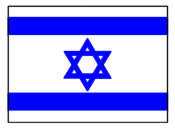
(7.) Men 43b. which quotes Exodus 24, 10 and Ezekiel 1, 26. (8.) Kitsur Shulchan Aruch 1, 9, #1. (9.) Jewish Catalog vol 1, p.53.
The Talmudic references to fringes were not entirely clear as to precisely how they were to be made. And as the tradition of the T'chelet, the blue thread, was forgotten, various suggestions have been made as to what a fringe should look like. A group in Jerusalem known as P'til Tekhelet is campaigning for the reintroduction of blue threads. Their web site shows the following illustration.
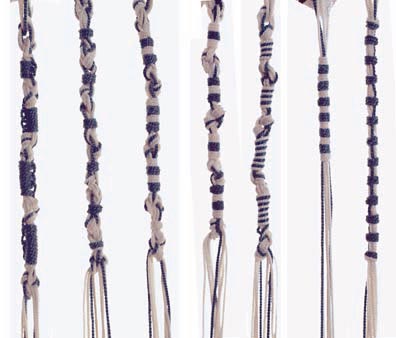 | ||||||
What is interesting is that various Rabbinic authorities had such different views on how to make tsitsit, and yet almost all those on sale today are of the uncoloured Radzyner type. This design goes back at least to the 16th century. Even if we ignore the blue threads being used, there is still much variation in the number of knots and the number of times the thread is bound round. More details of these tsitsit can be found on their web site at www.tekhelet.com
The  Tallit was the Hebrew name given to the large square outer garment worn widely in the Mediterranean area and Middle East from Biblical times onwards. Originally it was called Simlah or Salmah and was also used as a covering at night time. Hence the need for a lender who took one as pledge for a loan to return it before nightfall.10. During the first to third centuries CE, the Tallit was worn by all classes and became a Jewish garment only when tsitsit were attached to it otherwise it cannot be distinguished from the pallium or himation. (The latter were Roman and Greek garments.) This is because the tsitsit had the religious significance not the garment to which it was attached.11.
Tallit was the Hebrew name given to the large square outer garment worn widely in the Mediterranean area and Middle East from Biblical times onwards. Originally it was called Simlah or Salmah and was also used as a covering at night time. Hence the need for a lender who took one as pledge for a loan to return it before nightfall.10. During the first to third centuries CE, the Tallit was worn by all classes and became a Jewish garment only when tsitsit were attached to it otherwise it cannot be distinguished from the pallium or himation. (The latter were Roman and Greek garments.) This is because the tsitsit had the religious significance not the garment to which it was attached.11.
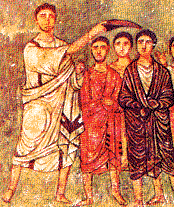 |
anointing David. 3rd cent. CE |
There is visual evidence to back up this view. Paintings from the 3rd Century Dura Europos Synagogue show a number of Jewish figures wearing garments like a Tallit, but only one has fringes attached. See illustration.
See also THE MODERN TALLIT below.
(10.) Deut. 24, 12-13. (11.) Rubens, A History of Jewish Costume, p.21. (12.) Baba Metsia 7a,and 8b. (13.) Baba Metsia 78b.
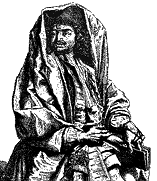 |
Amsterdam, 1733. |
The present use of the Tallit seems to have begun in Europe in the middle ages. The Jews living in these lands adopted western dress, the garments of which did not have four corners to place the tsitsit. So instead of putting fringes on ones every-day cloak, they had to don a special garment which was made for the fringes. This took two forms. The Tallit worn for prayer and the  Tallit katan (small Tallit) which was worn under ones garments. Sometimes, as in "Fiddler on the Roof", with the fringes hanging outside. The first mention of the Tallit Katan was in the Tur of Jacob ben Asher in the middle of the 14th century.14.
Tallit katan (small Tallit) which was worn under ones garments. Sometimes, as in "Fiddler on the Roof", with the fringes hanging outside. The first mention of the Tallit Katan was in the Tur of Jacob ben Asher in the middle of the 14th century.14.
The Tallit Katan was a small rectangle of material with a hole I the centre to put ones head through. This then hung down ones front and back, with two fringes to the front and two at the rear. The reason why the fringes hung outside was that the source verse said when you look upon them you shall remember the commandments. Hence they had to be visible reminders.
The Tallit is not worn at evening services, except at Kol Nidrei, following a Talmudic discussion which concluded that it must light enough to actually see the fringes.15.(14.) Rubens, op cit. p. 28. (15) Berachot 9a ff.
Is it permissible for a woman to wear a Tallit? Many Orthodox authorities rule it out because they claim that it is a positive commandment at a fixed time16. and women do not have to observe such commandments. But by saying that they do not have to observe the practice, it does not mean that they are forbidden to do so. It is the custom for women to wave the Lulav at Sukkot and eat matsot on the eve of Passover and say the appropriate blessings, although these are also positive commandments limited by time. The Talmud records the fact that at least two Rabbis (Rav Judah and Amram the Chasid) thought it right that the women in their households should wear tsitsit.17. Isserles in the Shulchan Aruch states that women are permitted to wear fringed garments and say the blessing over them.18.
A second objection is that a Tallit is a male garment, and the Bible forbids a man to wear women's clothes and a woman from wearing men's garments.19. This is clearly intended to prevent any "immorality" by transvestites. The development of the Tallit from a plain over garment to a specialised garment used for prayer is mentioned above. The development for males alone seems to be of relatively recent date. Any suggestion that immorality might occur as a result of a female wearing a Tallit in synagogue is totally ludicrous.
(16.) Kid 33b, Men 43a, etc. (17.) Men. 43a and Sukkah 11a. (18.) SA, Orach Chayim, 17, 2. (19.) Deut. 22, 5.
 |
ANIMATION: MAKING TSITSIT |
Sha'atnez is the term used for clothing made with a mixture of wool and linen fibres. This mixture is clearly forbidden in two places in the Torah. In Deuteronomy it states: You shall not sow your vineyard with different seeds  (Kila'im); lest the fruit of your seed which you have sown, and the fruit of your vineyard, be defiled.. You shall not plough with an ox and an ass together. You shall not wear a garment of different sorts
(Kila'im); lest the fruit of your seed which you have sown, and the fruit of your vineyard, be defiled.. You shall not plough with an ox and an ass together. You shall not wear a garment of different sorts  (Sha'atnez) , like wool and linen together.20. While in Leviticus it states: You shall keep my statutes. You shall not let your cattle breed with a different kind (Kila'im); you shall not sow your field with mixed seed (Kila'im); nor shall a garment mixed composition
(Sha'atnez) , like wool and linen together.20. While in Leviticus it states: You shall keep my statutes. You shall not let your cattle breed with a different kind (Kila'im); you shall not sow your field with mixed seed (Kila'im); nor shall a garment mixed composition  (Uveged Kila'im Sha'atnez) come upon you.21. The custom is therefore very ancient.
(Uveged Kila'im Sha'atnez) come upon you.21. The custom is therefore very ancient.
The reason for the law is not clear. Rashi pointed out that the Leviticus passage referred to it as Chok a statute, which he understood implied that no reason had to be given. However both passages link Sha'atnez with the mixing up of plant and animal species. All of these were clearly forbidden. At that time they believed that God deliberately created the world with different species of animals and plants, each one had its own seed in it and bred true to type. This was the order of God's creation and man should not interfere or debase it with it by cross-breeding animals or plants or by mixing up of fibres. Following this reasoning, Sha'tnez was mixing up was mixing up plant and animal fibres and so mixing up a God-ordered world. This is roughly the view of Nachmanides.22. (See also REASONS FOR BEARDS. and TRANSVESTISM. )
It is a strange fact that though many Jews observe the Jewish dietary laws, far fewer observe the law of Sha'atnez, although it has a similar origin and equal authority. For those few that do observe these laws, special laboratories have been set up to analyse the contents of cloths to check that they meet these strict requirements.
(20.) Deut. 22, 9 - 11. (21.) Lev. 19, 19. (22.) Commentary on Lev 19, 19.
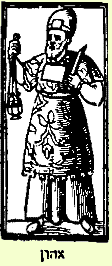 |
Haggadah, 1609. |
It is well known that Jews cover their heads for prayer; but few realise that the practice is comparatively recent. It is neither a Biblical nor a Rabbinic enactment, it is just a custom that gradually grew in importance. The Bible states that the High Priest wore a  (mitsnefet) (turban or as in old Christian translations a mitre)23. on which was a thread of blue; while the other priests wore turbans called
(mitsnefet) (turban or as in old Christian translations a mitre)23. on which was a thread of blue; while the other priests wore turbans called  (migba'ot).24. We read that Moses and Elijah covered their faces presumably so as not to look upon God.25. At the burning bush, Moses was told to remove his shoes 26. ( a custom observed for prayer by Yemenite Jews,) but he did not cover his head. In Talmudic times the Rabbis differed over covering the head. Those in Palestine were less inclined to wear hats but did so mostly on occasions of self-abasement such as in mourning, when fasting for a drought or when a cherem (ban) had been placed upon them. While in Babylon head covering was required for married men but not young bachelors,27. particularly for study, for prayer and the saying of blessings. But it is also said: Rabbi Huna son of R. Joshua would not walk four cubits bareheaded, saying: The Shechinah is above my head.28. In the 3rd century CE a synagogue in Syria had paintings on the walls showing the prophet Samuel and other figures without hats.
(migba'ot).24. We read that Moses and Elijah covered their faces presumably so as not to look upon God.25. At the burning bush, Moses was told to remove his shoes 26. ( a custom observed for prayer by Yemenite Jews,) but he did not cover his head. In Talmudic times the Rabbis differed over covering the head. Those in Palestine were less inclined to wear hats but did so mostly on occasions of self-abasement such as in mourning, when fasting for a drought or when a cherem (ban) had been placed upon them. While in Babylon head covering was required for married men but not young bachelors,27. particularly for study, for prayer and the saying of blessings. But it is also said: Rabbi Huna son of R. Joshua would not walk four cubits bareheaded, saying: The Shechinah is above my head.28. In the 3rd century CE a synagogue in Syria had paintings on the walls showing the prophet Samuel and other figures without hats.
In the middle ages a number of illustrated Haggadot (Passover eve prayer books) show respected Rabbis with uncovered heads.
 | 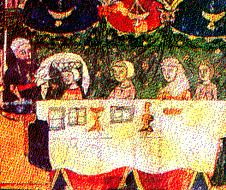 |
Rylands Haggadah, 1350. | |
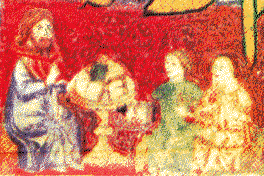 |
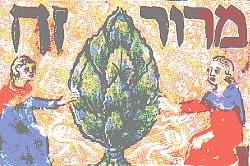 |
Kaufmann Haggadah c.1370. | From South Spain 1350. |

|
|
Germany c. 1300. |
It is significant that all the illustrations above are taken from Spanish Haggadot as Jews of France and Spain followed Palestinian customs, while Jews in the area of Germany followed the Babylonian traditions. Figures in Ashkenazi Haggadot of this time invariably have their heads covered, even if they have bird's heads. The Sephardim have a mixture of heads bare and covered within the same Haggadah, showing that the practice was not yet fully established. As late as the 16th century Rabbi Solomon Luria (Maharashal) wrote saying there was no rule against praying bare-headed.29. While about the same time, Joseph Caro in the Shulchan Aruch categorically stated that it was forbidden.30.
From that time on, the custom was widely accepted until the 19th century, when some congregations of Reform and Liberal Jews returned to the old practice of bare-headedness. In Britain today, almost every congregation insists that the worshipper covers his head.
(23.) Ex. 28, 4 & 37. (24.) Ex. 28, 40. (25.) Ex. 3, 6 & 1 Kings, 19, 13; for not looking upon God, see Ex. 33, 20. (26.) Ex. 3, 5. (27.) Kid. 29b. (28.) Kid 31a. (29.) Responsum No. 7. (30.) Orach Chayim 2, 6.
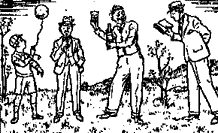 |
|
Wise son has a Homburg not a copul. London, 1937. |
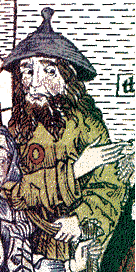 |
Nuremberg Chronicle, 1493. |
Being a custom and not a mitsvah, there is not a biblical verse to base it on. The following possible explanations have been suggested:
(31.) Shab.156b. (32.) EJ, vol 8, p. 5.
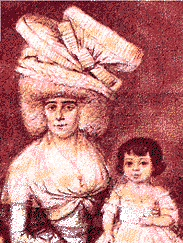 |
taken too far. London, 1797. |
Jewish tradition took a different view on head covering for men and for women. Male leaders took the view that the sight of women's hair was sexually provocative.33. Therefore, women were required to wear hats to cover their hair rather than their heads. Later the Shulchan Aruch declared that it was forbidden to pray in the sight of women.34.
In biblical times some women wore veils 35. In the Talmud it states: Men sometimes cover their heads and sometimes not; but women's hair is always covered.36. Some women in early periods wore wigs to cover their natural hair. In about the 16th century in Italy the custom was introduced of married women shaving their heads and wearing a sheitel (Yiddish for wig) instead.37. By modern times this custom had come full circle, because many modern wigs are more beautiful than the natural hair that they replace, and therefore defeated the original object of the custom. The sheitel is only worn by the most orthodox of Jewish women.
(33.) Ber 24a. (34.) SA Orach Chayim 75, 2. (35.) Gen. 24, 65. (36.) Ned. 30b. (37.) Jacob Emden: Responsa 1, 9 as quoted by Freehof: Current Reform Responsa p. 229.
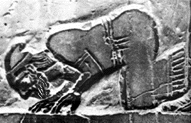 |
c. 845 BCE. |
In Biblical times Jews apparently kept their beards. (accompanying illustration) The Bible states: You shall not round the corners of your heads, nor shall you mar the corners of your beard.38. And Cohanim (priests) were told: They shall not make bald any part of their head, nor shall they shave off the corner of their beard, nor make any gashes in their flesh.39.
The corner of the beard is taken to be the place where the beard begins to grow at puberty. Among ultra-orthodox Jews it became the custom to let the hair at their temples grow long and they often curled these into spirals. They were called Pe'ot (corners).
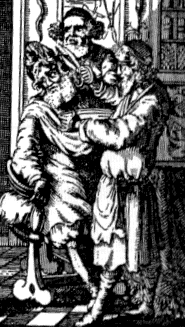 |
| Haircut, Holand, 1657. |
The Rabbis ruled that shaving with a razor (single blade) was not permitted, but trimming with scissors (two blades) was allowed.40. Hence most modern electric razors are permitted and so are depilatory creams.
In the middle ages, Jews of Italy, France and Germany tended not to have beards, while those in Islamic countries like Greece and Turkey kept their beards. In the 17th and 18th centuries, the controversy became serious when Rabbis in Salonica tried to force Italian Jews there to grow their beards. Italian Rabbis like Samson Morpurgo had to come to their defence.41. Today, while the most orthodox of Jews wear their beards, many of the mainstream and reform Jews are clean shaven.
The following quotations illustrate the variations in views held:
(38.) Lev. 19, 27. (30.) Lev. 21,5. (40.) Mak. 3, 5 & 21a.(41.) Freehof: Treasury of Responsa. Pp. 190 ff. (42.) Saying quoted in Shab. 152a. (43.) Joseph Solomon of Medigo as quoted in JE vol 2, p. 613. (44.) San 100b.
(45.) Abarbanel on Lev. 19, 27.
There is a biblical verse concerning cross dressing which says: The woman shall not wear that which belongs to a man, neither shall a man put on a woman�s garment; for all who do so are abomination to the Lord your God.46. Various suggested reasons have been put forward for this prohibition, namely:
Whatever was the original reason, it has encouraged a few strictly Orthodox Rabbis to forbid women wearing trouser suits from entering a synagogue. (Although the cut of such trouser suits make them clearly different from men's suits.) There is even some doubt as to whether a Scottish Jewish male should be allowed wear a kilt in Synagogue, although there is a long history of the garment being used as male military uniform.
(46.) Deut, 22, 5. (47.) J.H.Hertz commentary on Deut. 22, 5 and on 2 Kings 23, 7. (48.) Gen. 1, 28.
The customs connected with the wearing of a new garment have altered in recent ages. In times past it was customary for a Jew to say a blessing when putting a garment on for the first time: Blessed are You Lord our God, Ruler of the universe who has kept us alive, preserved us and enabled us to reach this season.49. While another prayer book 50. states that that blessing is said when one buys the new garment and when wearing it for the first time one says: Blessed are You, Lord our God, Ruler of the universe who clothes the naked. And anyone seeing him or her with a new piece of clothing often said I wish you well to wear it. With the rise in the standard of living, people can afford more clothes than those of previous generations and the putting on of a new garment is less of a rarity, therefore these customs appear to be dropping out.
(49.) Singer's Prayer Book and others. (50.) Art Scroll Siddur pp.230/1
| FOR FULL ALPHABETICAL INDEX OF CUSTOMS |